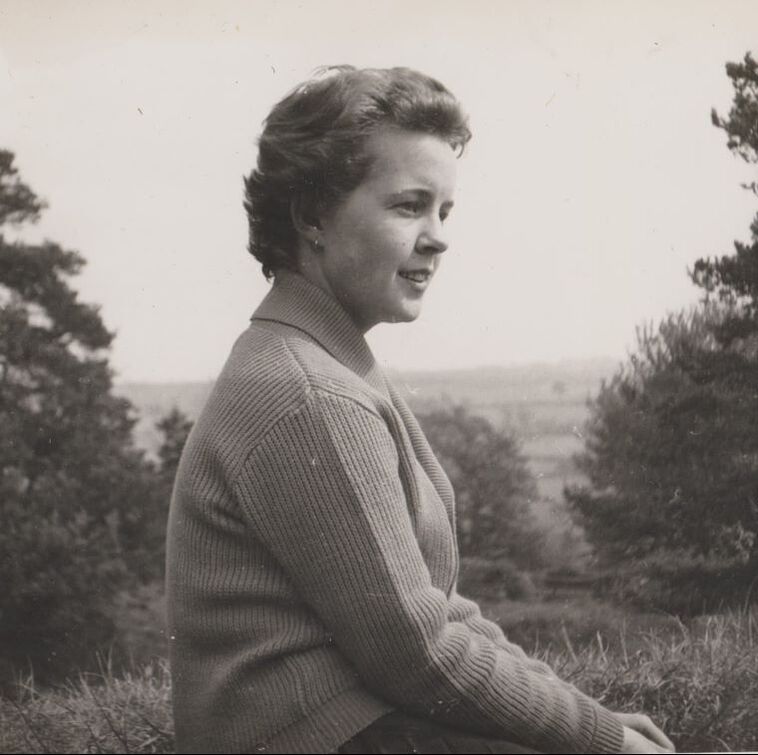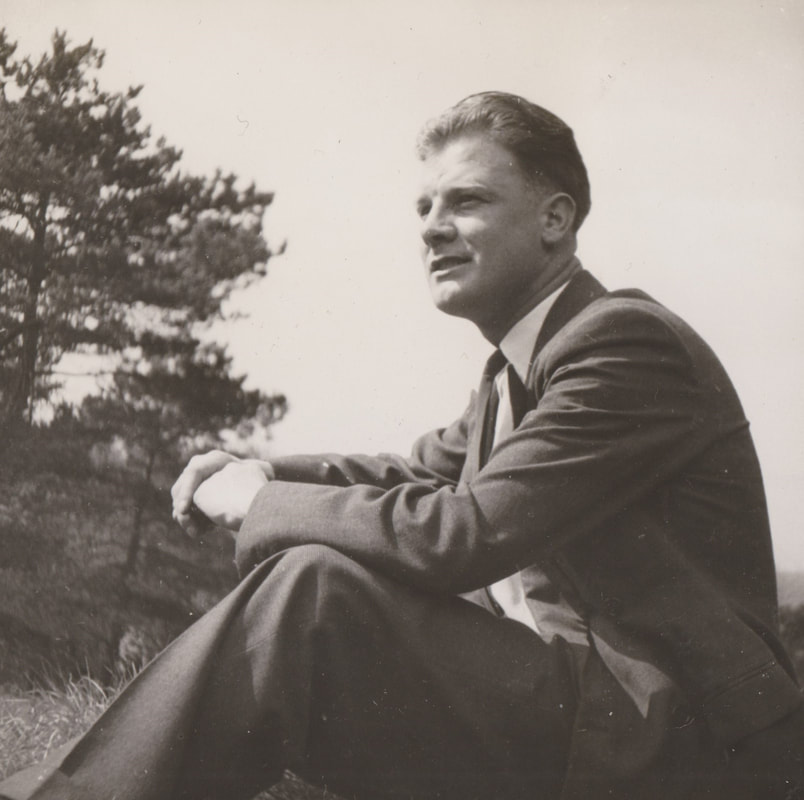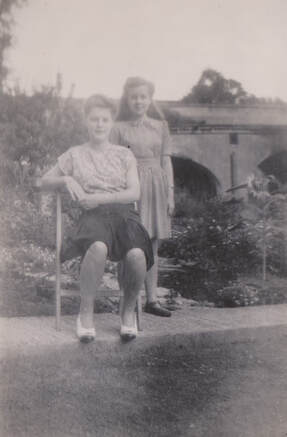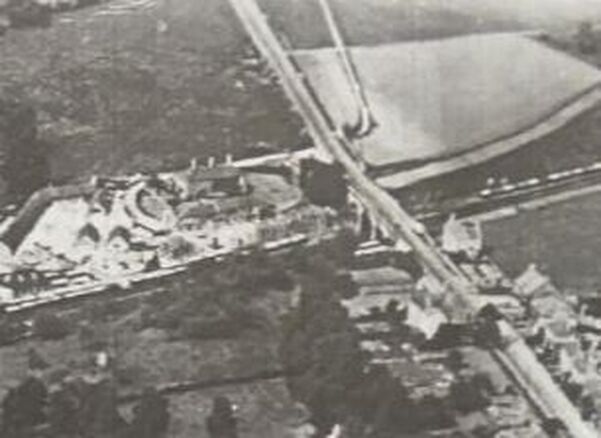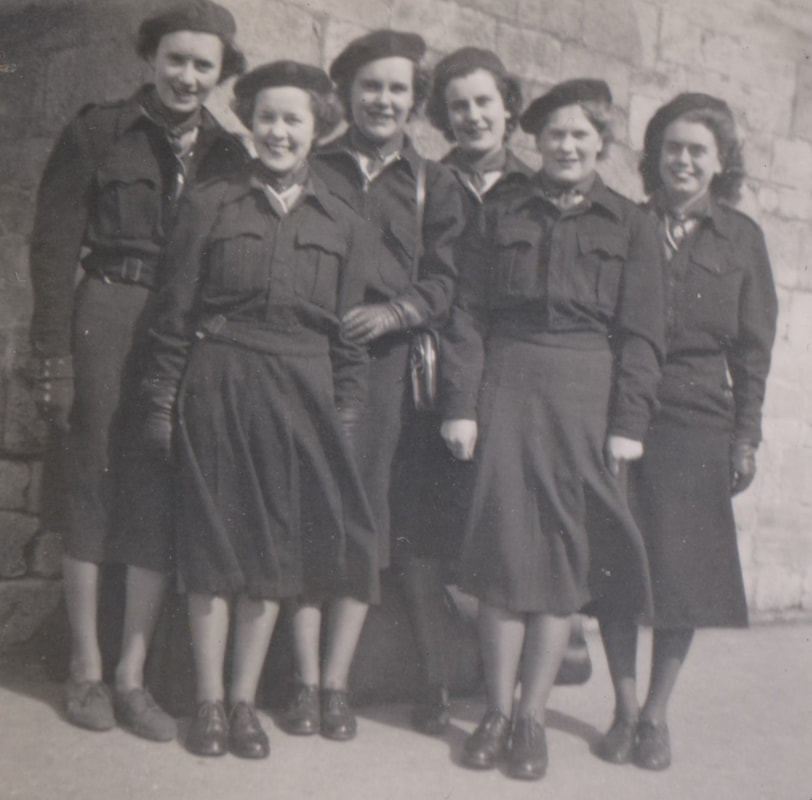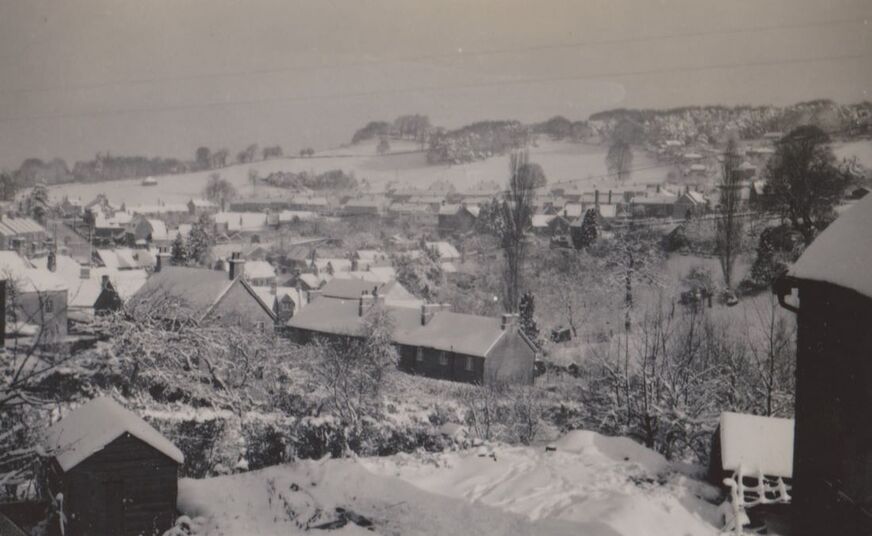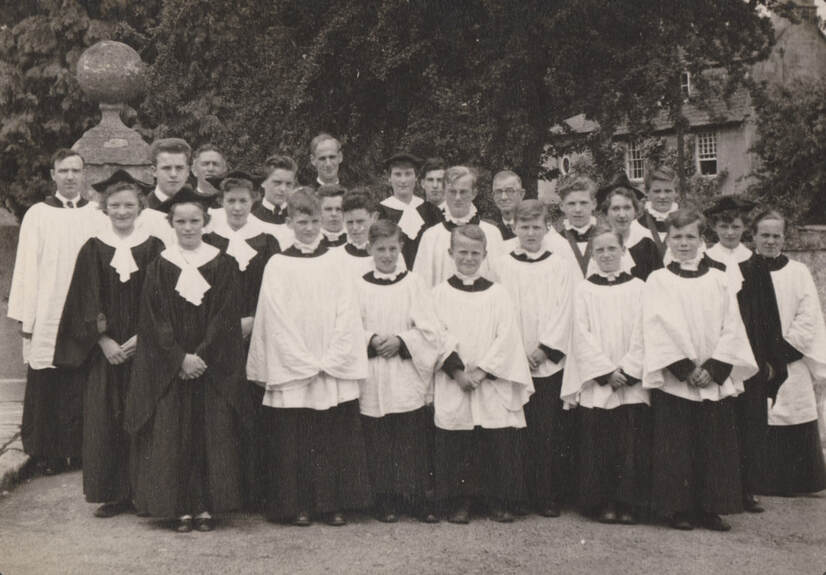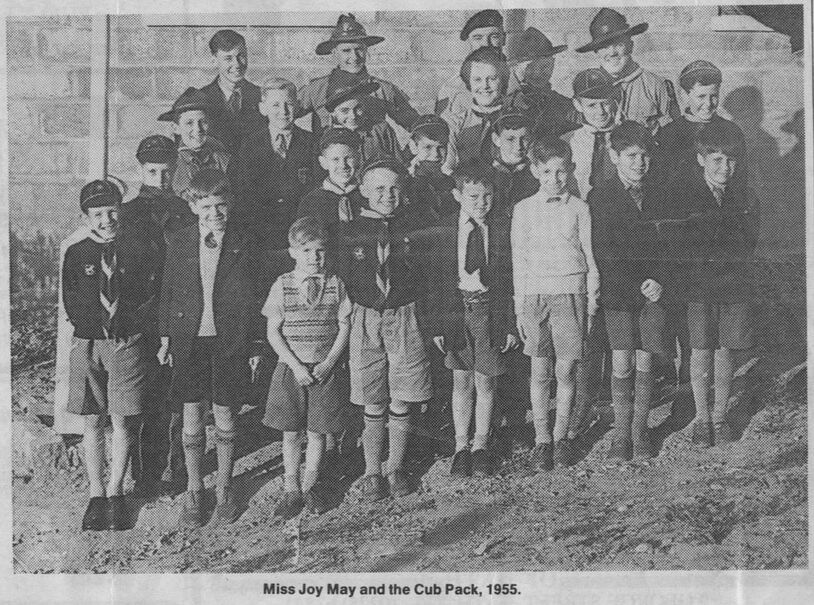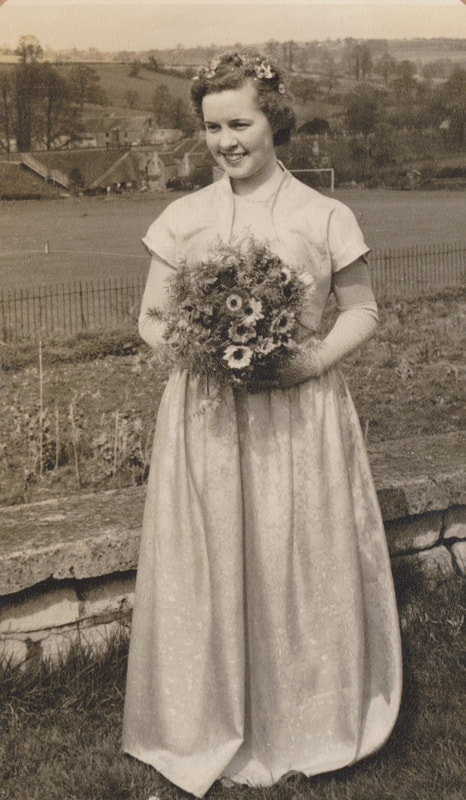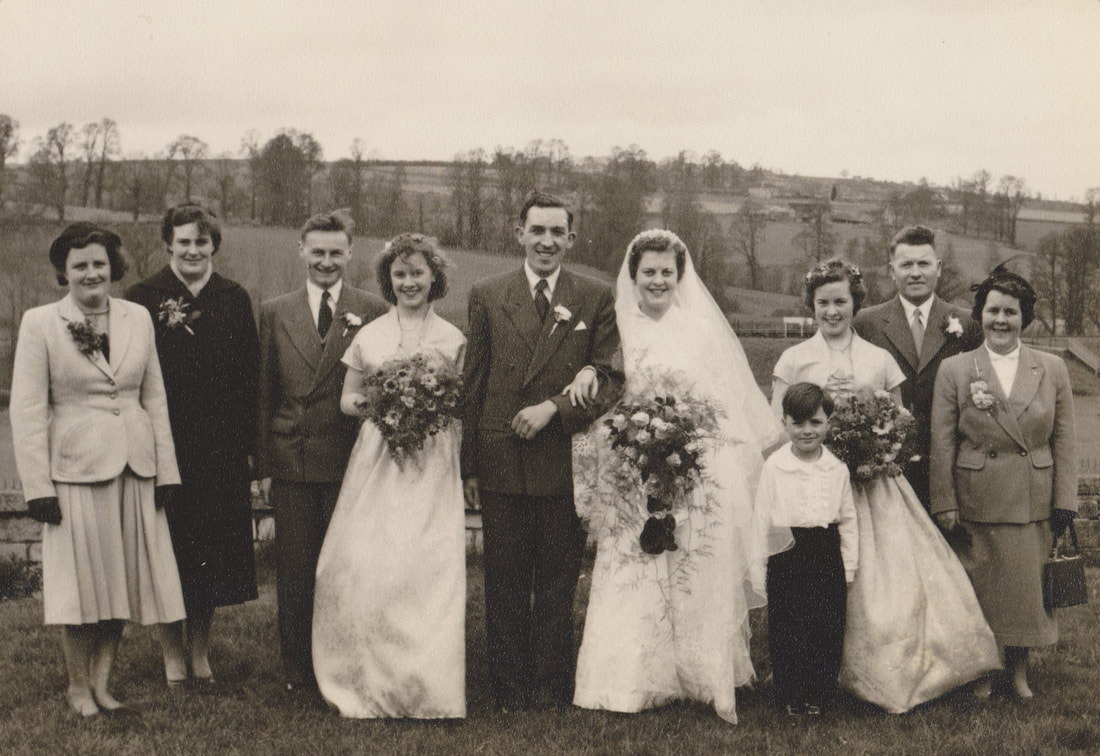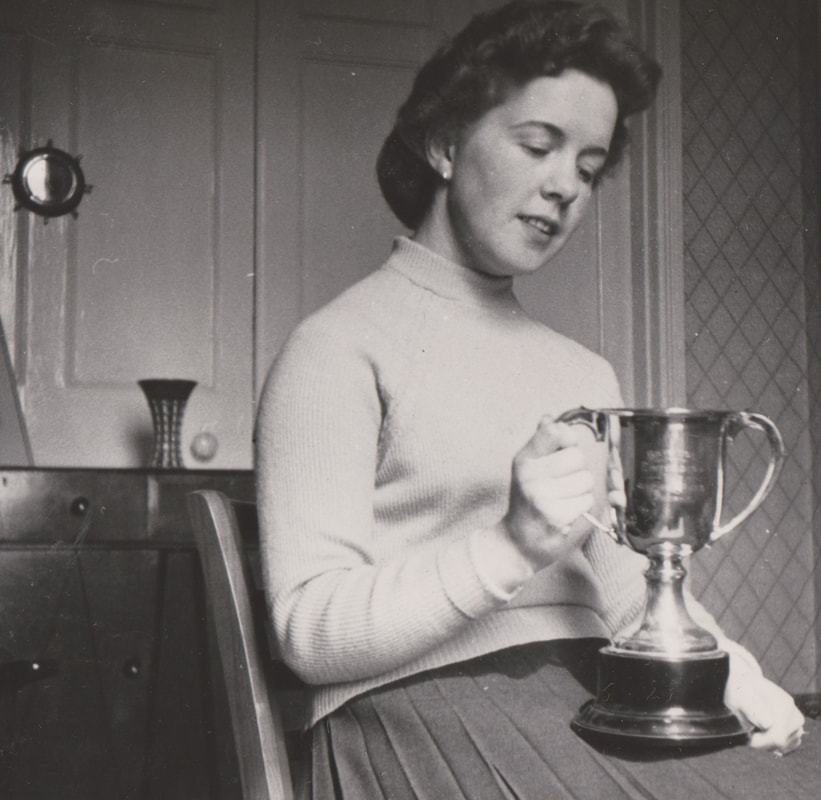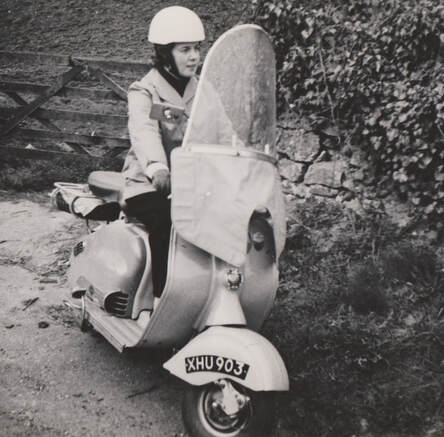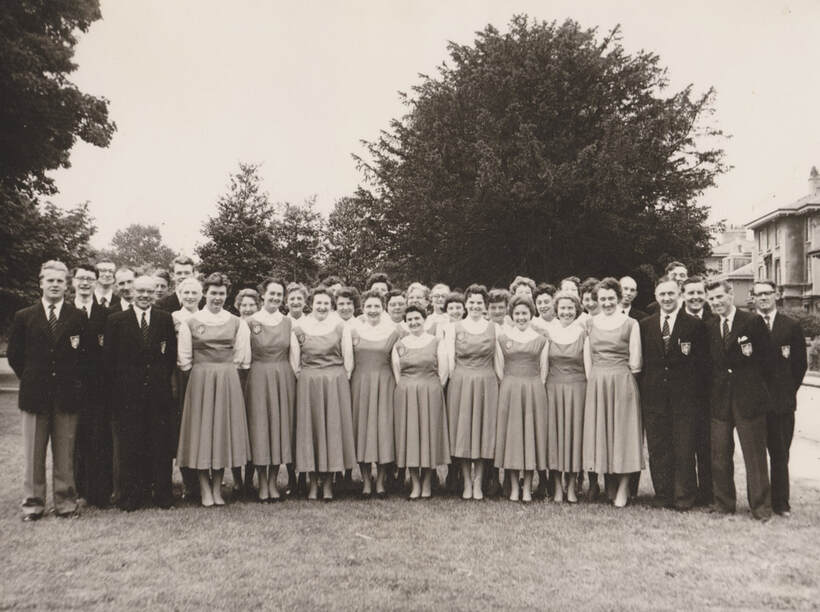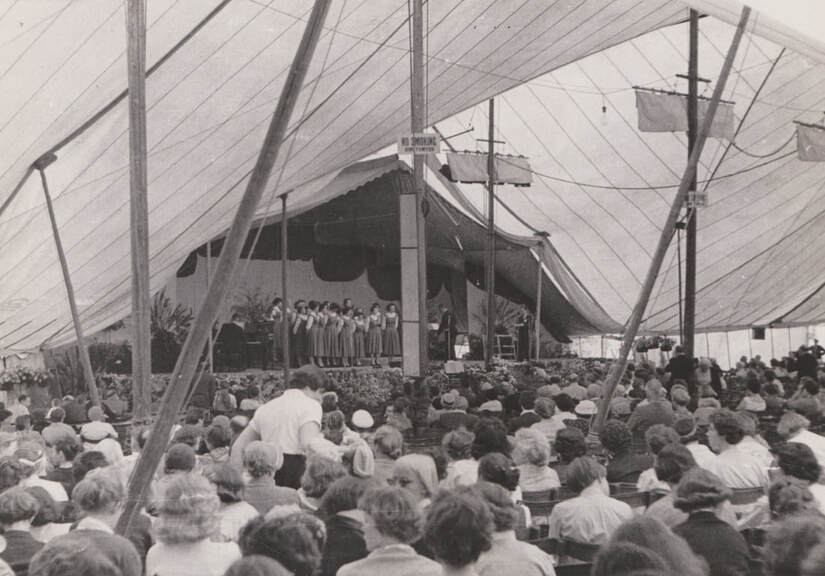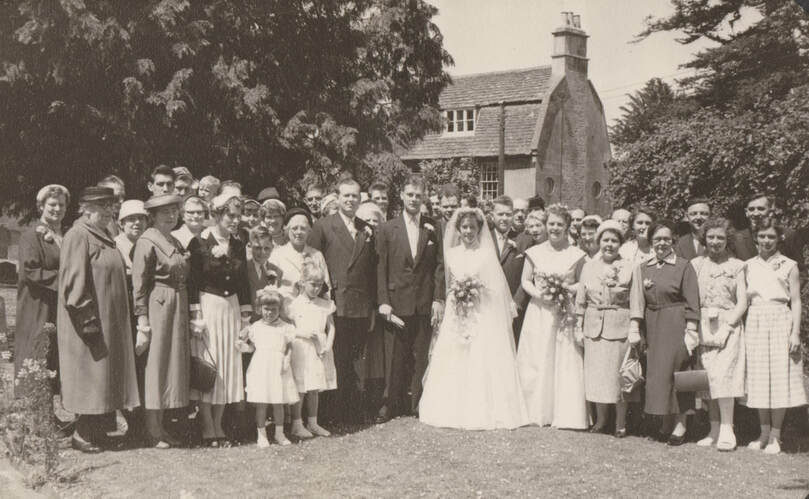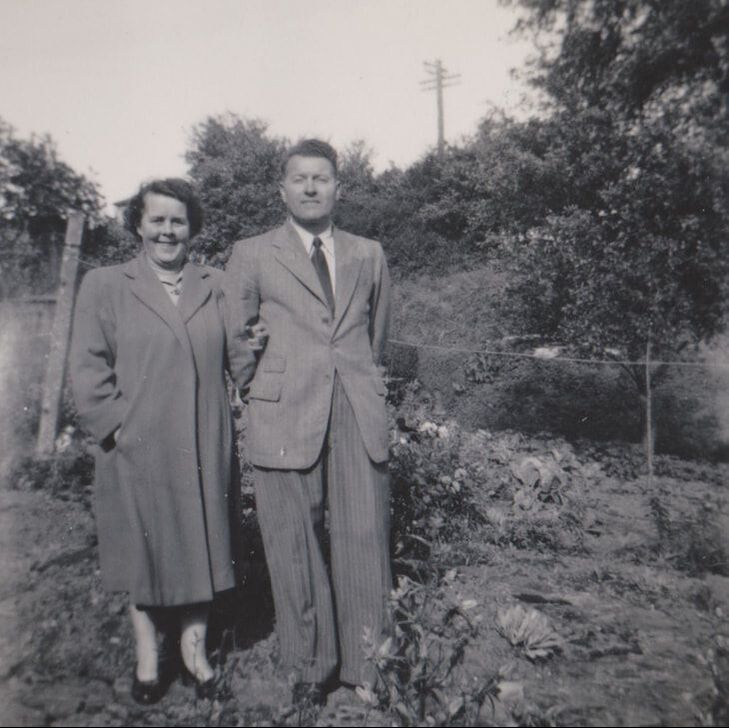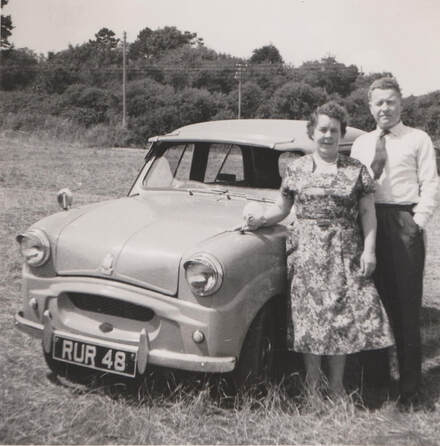May Family in 1950s Photos Maureen Boulton, Alan Payne, July 2019
Above Maureen and Ken Boulton on honeymoon in Torquay following their wedding on 15 June 1957
We all have memories of the years when we grew up from childhood to an adult life, and took on responsibilities, often marriage and family. It was much the same in 1950s Box but the route was a lot simpler and with considerably less anxiety than that experienced by modern teenagers. We look at the journey to adulthood through the experience of Maureen May before her marriage to Ken Boulton.
The May Family
In Box, the May family were associated with the quarry trade but that wasn’t always the case. They originally came from Corshamside, now usually called Neston, where the family were chairmakers. We sometimes associate traditional hand-made chairs with the arts and crafts movement, but that is seeing history in retrospect. In the early years of Queen Victoria, Samuel May and his wife Mary Ann, were simply earning a living by making furniture that was in demand possibly for the Neston Park Estate acquired by the Fuller family who rebuilt Neston House after 1790. Demand grew in the Victorian period when the focus on family and status meant more people wanted possessions and had the money to pay for them. Samuel’s business appears to have been profitable because he employed two apprentices in 1851 until his sons came into the business.
On Samuel’s death about 1856, Mary Ann and the children continued the business. It provided an income for three of the boys in 1861 but small, local production ceased to be economic in the face of factory-made furniture. Samuel’s middle son, Thomas, switched to become a stone miner at Bradford-on-Avon in 1871 and returned to Corshamside ten years later. Their eighth child and fourth son (Maureen’s grandfather), Alfred, joined the Wiltshire militia aged 17 in 1893 before following his father’s trade as a freestone quarryman at The Snatches, Neston, by 1901. The family were still in Neston in 1911 and only came to Box later.
The Wharf, Stoneyard
Box Stone Wharf at the foot of Box Hill was a prime part of the stone industry business owned by Pictor & Sons and later the Bath & Portland Stone Firms. Quarried stone blocks were usually weathered underground before being loaded onto gravity-driven rail trucks at Clift Quarry Works and allowed to free-load downhill on rails running along the line of the current Beech Road to The Wharf. The trucks sped under the A4 road before coming to a halt on an incline next to the western edge of The Bassetts. Once it had been unloaded the stone was shaped into manageable blocks.
The Wharf area was built in 1864 as a railway siding for the transport of stone on the Great Western Railway.[1] It was vital that the yard was managed properly and the foreman of the yard was a very responsible job. The first foreman was John Shell master mason employing 23 men and 3 boys in 1871. Numbers reduced considerably by 1881 to 7 men and 5 boys when the cottages were called Bridge Cottages, later known as Wharf Cottages.
In Box, the May family were associated with the quarry trade but that wasn’t always the case. They originally came from Corshamside, now usually called Neston, where the family were chairmakers. We sometimes associate traditional hand-made chairs with the arts and crafts movement, but that is seeing history in retrospect. In the early years of Queen Victoria, Samuel May and his wife Mary Ann, were simply earning a living by making furniture that was in demand possibly for the Neston Park Estate acquired by the Fuller family who rebuilt Neston House after 1790. Demand grew in the Victorian period when the focus on family and status meant more people wanted possessions and had the money to pay for them. Samuel’s business appears to have been profitable because he employed two apprentices in 1851 until his sons came into the business.
On Samuel’s death about 1856, Mary Ann and the children continued the business. It provided an income for three of the boys in 1861 but small, local production ceased to be economic in the face of factory-made furniture. Samuel’s middle son, Thomas, switched to become a stone miner at Bradford-on-Avon in 1871 and returned to Corshamside ten years later. Their eighth child and fourth son (Maureen’s grandfather), Alfred, joined the Wiltshire militia aged 17 in 1893 before following his father’s trade as a freestone quarryman at The Snatches, Neston, by 1901. The family were still in Neston in 1911 and only came to Box later.
The Wharf, Stoneyard
Box Stone Wharf at the foot of Box Hill was a prime part of the stone industry business owned by Pictor & Sons and later the Bath & Portland Stone Firms. Quarried stone blocks were usually weathered underground before being loaded onto gravity-driven rail trucks at Clift Quarry Works and allowed to free-load downhill on rails running along the line of the current Beech Road to The Wharf. The trucks sped under the A4 road before coming to a halt on an incline next to the western edge of The Bassetts. Once it had been unloaded the stone was shaped into manageable blocks.
The Wharf area was built in 1864 as a railway siding for the transport of stone on the Great Western Railway.[1] It was vital that the yard was managed properly and the foreman of the yard was a very responsible job. The first foreman was John Shell master mason employing 23 men and 3 boys in 1871. Numbers reduced considerably by 1881 to 7 men and 5 boys when the cottages were called Bridge Cottages, later known as Wharf Cottages.
Parents, Albert Edward and Kate May
Maureen’s parents Albert Edward May and Kate Sophia Pearce always called each other Ted and Kit. They married in 1931 when Albert was a twenty-nine-year-old quarry employee and Kate was twenty-six. She was the fifth child of Henry and Ellen Pearce, an underground quarry-worker family and Kate’s mother Ellen was a main supporter of the Methodist Velley Hill chapel, Gastard. On her death in 1932, Kate wrote a mourning card Peace, peace, peace from Kitty, Albert and Baby Joy.[1] Maureen was born in Potley Lane, Corsham a year later in 1934.
Maureen’s parents Albert Edward May and Kate Sophia Pearce always called each other Ted and Kit. They married in 1931 when Albert was a twenty-nine-year-old quarry employee and Kate was twenty-six. She was the fifth child of Henry and Ellen Pearce, an underground quarry-worker family and Kate’s mother Ellen was a main supporter of the Methodist Velley Hill chapel, Gastard. On her death in 1932, Kate wrote a mourning card Peace, peace, peace from Kitty, Albert and Baby Joy.[1] Maureen was born in Potley Lane, Corsham a year later in 1934.
Above Left: Joy and Maureen May in their garden in 1947 and Right: Aerial view with the Clift Quarry rail track going under A4 (courtesy Varian Tye)
The family moved to 2 The Wharf in August 1939 where Albert was the Box quarry manager for the Bath & Portland Stone Firms, General Foreman of Stone Mine and Works. He was too young for active duty in the First World War and served as an ARP warden and Special Constable in the Second.[3] The Wharf homes were close to the underground tunnel (seen left of the railway tunnel in this photograph) where the rail track from the Clift Quarry Works ran under the A4 to the Wharf Stoneyards.
His work at The Wharf was one of the most important jobs in the whole of Box and he often represented the Firms on official duty.[4] For a time, 2 The Wharf was the local Bath & Portland Offices when The Wharf Stoneyard was closed after the war. This situation changed when Albert was made foreman at Hartham Park Quarry in 1953, still working for the Bath & Portland Firms, for whom his role was mostly inspection of sites using the company van provided to him. Albert and Kate later moved to a house in Westwells Road. By then the May family had spread into different locations in Box. Albert’s brother Alfred Thomas George May married Gladys Pearce, elder sister of Kate, in 1925.
His work at The Wharf was one of the most important jobs in the whole of Box and he often represented the Firms on official duty.[4] For a time, 2 The Wharf was the local Bath & Portland Offices when The Wharf Stoneyard was closed after the war. This situation changed when Albert was made foreman at Hartham Park Quarry in 1953, still working for the Bath & Portland Firms, for whom his role was mostly inspection of sites using the company van provided to him. Albert and Kate later moved to a house in Westwells Road. By then the May family had spread into different locations in Box. Albert’s brother Alfred Thomas George May married Gladys Pearce, elder sister of Kate, in 1925.
Life in 1950s
The years between the end of the Second World War and the 1960s reflected many of the ethics of wartime with deference to elders shown by the use of titles, Mr and Mrs to neighbours and auntie or uncle to family friends. Titles mirrored the use of rank for members of the armed services and many elderly people retained their military rank in civil life. Military service still dominated civilian life when National service (peacetime conscription) gave military training and discipline to young men, like Ken Boulton (later Maureen’s fiancée). It was thought to be needed. The threat of war with Russia loomed after the Soviet blockade of Berlin in 1948, actual conflict emerged in Korea between 1950 and 1953, and again with the Mau Mau rebellion in Kenya which lasted for much of the 1950s. The defence of Britain’s Empire and its interests dominated British politics. They helped to get the elderly Churchill elected as Prime Minister and the invasion of Egypt in November 1956 (the so-called Suez Crisis) ended the career of his successor, Sir Anthony Eden.
The years between the end of the Second World War and the 1960s reflected many of the ethics of wartime with deference to elders shown by the use of titles, Mr and Mrs to neighbours and auntie or uncle to family friends. Titles mirrored the use of rank for members of the armed services and many elderly people retained their military rank in civil life. Military service still dominated civilian life when National service (peacetime conscription) gave military training and discipline to young men, like Ken Boulton (later Maureen’s fiancée). It was thought to be needed. The threat of war with Russia loomed after the Soviet blockade of Berlin in 1948, actual conflict emerged in Korea between 1950 and 1953, and again with the Mau Mau rebellion in Kenya which lasted for much of the 1950s. The defence of Britain’s Empire and its interests dominated British politics. They helped to get the elderly Churchill elected as Prime Minister and the invasion of Egypt in November 1956 (the so-called Suez Crisis) ended the career of his successor, Sir Anthony Eden.
|
Conscription only applied to young men and for Maureen it was the Girl Guide Rangers, the church and clerical training which offered practical, good life skills. She then trained as a secretary for three years at Canning's College, Bath in 1947, passing with distinction in shorthand, typing and business studies in 1949 and winning the Bath Chronicle Shield in 1950. After leaving school, she worked in Bath for three years with the Commercial Union Assurance Company, then a couple of years with Titley, Long & Co, Solicitors. After this she worked at George Browning Ltd in Box until she met and married Ken Boulton, newly-returned from National Service. Left: Maureen and Ranger Guides at training camp in Seend Below: The view over Box from Browning’s Office window |
The desire to move on from wartime hardships was reflected with the Olympic Games (the so-called Austerity Games) in London in 1948, but the exclusion of Germany and Japan hardly encouraged national reconciliation. The Festival of Britain in 1951 sought to commemorate the centenary of the Great Exhibition but, unlike the innovation of the original, a mood of old-fashioned neo-Romanticism dominated an otherwise rather boring event.
Local Events
In the village there was a desire to return to pre-war years, with many young people joining the Gay Nineties Dance Club and celebrating New Year’s Eve in the Bingham Hall. The club also offered coach outings including trips to Ilfracombe in 1951.
Local Events
In the village there was a desire to return to pre-war years, with many young people joining the Gay Nineties Dance Club and celebrating New Year’s Eve in the Bingham Hall. The club also offered coach outings including trips to Ilfracombe in 1951.
Above: Maureen and Mary Orford in the Box Church Choir August 1956 with new vicar Tom Selwyn-Smith.
Below: Leading the troop, Joy, Len Weeks and Alec Cogswell and scout and cubs including Phil Martin and Bob Hancock (courtesy Phil Martin)
Below: Leading the troop, Joy, Len Weeks and Alec Cogswell and scout and cubs including Phil Martin and Bob Hancock (courtesy Phil Martin)
The coronation of Princess Elizabeth in June 1953 seemed to usher in a new Elizabethan Age of hoped-for prosperity after years of adversity, and the wedding of Joy, Maureen’s sister, in the Methodist Church in April 1954 was full of elegant clothing (rather than wartime utility) and an element of extravagance. The bride wore a dress of white brocade, with a full-length veil and headdress of orange blossom. The bridesmaids Maureen May (sister) and Shirley May (cousin) wore mauve figured taffeta dresses with headdresses and bouquets of anemones.[5] Joy and Robert went on honeymoon to London as freedom to travel became more common in the 1950s. Before her marriage, Joy May ran the Box Cubs in the village along with Len Weeks as her assistant, until domestics and work at the Avon Rubber took over her leisure time and she retired in April 1954.[6]
It was just the start of increased road traffic and greater personal mobility. Ken used a Lambretta scooter to get around in the late 1950s but Maureen couldn’t reach the ground sitting on it, so she only posed for a photo (seen below right). The vehicle was very popular in the West and a Lambretta Museum existed in Weston-super-Mare in the 1950s. The 125cc model had a twin-stroke engine and a top speed of about 40mph.
As coach travel gathered pace, Maureen went on frequent outings with the Silver Ring Choir, Bath: to Lyme Regis in June 1955 and Eastbourne in July 1955. Under choirmaster Kelvin Thomas, the choir went on to represent the area in the Llangollen International Eisteddfod in July that year and again the next summer. At the Bristol Eisteddfod in April 1958 Maureen and Hilary Bryant won first prize for their duet and were awarded a cup to commemorate their victory (above left).
Above: Silver Ring Choir assembling at the Llangollen Competition, 9 July 1955. On the right Charles Shipley and Don Hill of Bath.
Below: Performing on stage
Below: Performing on stage
Marriage to Ken Boulton, 15 June 1957
The Boulton and May families had known each other for many years. In 1941 Kenneth, Joan and Beryl Boulton won first, second and third prizes for good conduct at the Box Methodist Chapel whilst Maureen and Joy were also prize winners.[7] It was no surprise when Ken and Maureen married.
The Boulton and May families had known each other for many years. In 1941 Kenneth, Joan and Beryl Boulton won first, second and third prizes for good conduct at the Box Methodist Chapel whilst Maureen and Joy were also prize winners.[7] It was no surprise when Ken and Maureen married.
They left their parent’s houses to set up their own home during 1957 in a flat in Bath, then back to Box to one floor of Springfield House, Church Lane, with no bath and a toilet on the landing outside their front door. The year of the their wedding 1957 was a somewhat seminal year, foretelling some of the themes of the 1960s. John Osbourne’s play Look Back in Anger was running to packed audiences in the West End and ushering in the so-called period of Kitchen sink drama; Ghana became the first British colony in Africa to gain independence; and Britain tested the hydrogen bomb. That year the Queen opened the country’s first nuclear power station, leading to the formation of the Campaign for Nuclear Disarmament. In Box, the change was marked by the growth of private motor cars in time for the M1, Britain’s first complete motorway in 1959. It was the start of a new era in Box and the country.
In 1960 their son Simon was born. However. Maureen and Ken didn’t stay long in the village and in 1962 they moved to Aden in the Yemen where Ken was employed as a state engineer. They were there for three years and it proved to be an ideal move with Ken playing cricket and hockey and Maureen performing in amateur dramatics and operettas including The Mikado which was presented to the troops on Ark Royal with accompaniment from the marines band. Afterwards Ken and Maureen returned to the UK at St Leonards, Hastings for 27 years where Ken worked for Phillips until his retirement in 1989. Maureen worked for the Pestalozzi International Children’s Village, Sedelscomb, a charity for war orphans to receive further education before returning to their country of origin to pass the education on to others.
In 1960 their son Simon was born. However. Maureen and Ken didn’t stay long in the village and in 1962 they moved to Aden in the Yemen where Ken was employed as a state engineer. They were there for three years and it proved to be an ideal move with Ken playing cricket and hockey and Maureen performing in amateur dramatics and operettas including The Mikado which was presented to the troops on Ark Royal with accompaniment from the marines band. Afterwards Ken and Maureen returned to the UK at St Leonards, Hastings for 27 years where Ken worked for Phillips until his retirement in 1989. Maureen worked for the Pestalozzi International Children’s Village, Sedelscomb, a charity for war orphans to receive further education before returning to their country of origin to pass the education on to others.
Below left: Maureen's parents, Albert and Kate May in July 1954 and Right: On holiday at Beer in 1959.
Back to Box
Maureen and Ken returned to Corsham in 1992, to discover that life had continued much the same. Maureen’s mother Kate May was a good but plain cook, whereas sister Joy was an expert pastry and cake maker. Albert had an allotment at Box Brook along the path that ran from The Wharf to Mill Lane. Whilst he gardened, Kate fished in the Brook. Albert was the secretary for the Comrades Club (now called Hardy House) for over fourteen years, often spending his evenings there, smoking his pipe and reminiscing about times gone by. Albert and Kate rarely went on holiday but visited country pubs on the weekend or on outings in their company car. They were chapel folk, happy in their rented cottage at The Wharf, one of the best-known and widely-admired Box families.
Maureen and Ken returned to Corsham in 1992, to discover that life had continued much the same. Maureen’s mother Kate May was a good but plain cook, whereas sister Joy was an expert pastry and cake maker. Albert had an allotment at Box Brook along the path that ran from The Wharf to Mill Lane. Whilst he gardened, Kate fished in the Brook. Albert was the secretary for the Comrades Club (now called Hardy House) for over fourteen years, often spending his evenings there, smoking his pipe and reminiscing about times gone by. Albert and Kate rarely went on holiday but visited country pubs on the weekend or on outings in their company car. They were chapel folk, happy in their rented cottage at The Wharf, one of the best-known and widely-admired Box families.
Family Tree
Samuel (b 1802), a chairmaker, and Mary Ann (b 1803) lived at Corshamside (Neston) for long periods of their lives. Children:
Charlotte Catherine (b 1829); Alfred (b 1830); Sarah (b 1831); Ellen (b 1836); Eleanor (b 1837); Selina (b 1838); Job (b 1840); Thomas (b 1842); George (b 1844).
Thomas (b 1842) was described as a chairmaker in 1861 and as a stone miner in 1881. He married Roth (b 1840). Children:
Henry Thomas (b 1865); John (b 1867); Edward (b 1868); Emily (b 1870); Eliza (b 1871); Annie M (b 1873); Charlotte C (b 1874); Alfred (b 1875); Ellen (b 1879); Samuel (b 1881, died in infancy); and Rosalie (b 1883).
Grandparents: Alfred (9 November 1875 - 1960), underground stone quarryman from Corshamside and Eliza Ann Bollen (b 29 January 1876). Children, all born at Corshamside:
Daisy EL (b 1897); Gladys Norah (b 1899); Alfred Thomas George (b 1901); Albert Edward (b 1902); Evelyn Mildred (b 1903); William Frank (b 1908); and Violet Beatrice (b 1910).
Parents: Albert Edward May (b 29 December 1902) and Kate S Pearce (b 17 November 1905 - 1986). Albert was General Foreman of Stone Mine and Works, and in 1953 foreman at Hartham Park Quarry. Children:
Marjorie Joy May was cub leader for the Box Scout Group, who married Robert George Bailey in April 1954;
Maureen Anne May (b 1934).
Samuel (b 1802), a chairmaker, and Mary Ann (b 1803) lived at Corshamside (Neston) for long periods of their lives. Children:
Charlotte Catherine (b 1829); Alfred (b 1830); Sarah (b 1831); Ellen (b 1836); Eleanor (b 1837); Selina (b 1838); Job (b 1840); Thomas (b 1842); George (b 1844).
Thomas (b 1842) was described as a chairmaker in 1861 and as a stone miner in 1881. He married Roth (b 1840). Children:
Henry Thomas (b 1865); John (b 1867); Edward (b 1868); Emily (b 1870); Eliza (b 1871); Annie M (b 1873); Charlotte C (b 1874); Alfred (b 1875); Ellen (b 1879); Samuel (b 1881, died in infancy); and Rosalie (b 1883).
Grandparents: Alfred (9 November 1875 - 1960), underground stone quarryman from Corshamside and Eliza Ann Bollen (b 29 January 1876). Children, all born at Corshamside:
Daisy EL (b 1897); Gladys Norah (b 1899); Alfred Thomas George (b 1901); Albert Edward (b 1902); Evelyn Mildred (b 1903); William Frank (b 1908); and Violet Beatrice (b 1910).
Parents: Albert Edward May (b 29 December 1902) and Kate S Pearce (b 17 November 1905 - 1986). Albert was General Foreman of Stone Mine and Works, and in 1953 foreman at Hartham Park Quarry. Children:
Marjorie Joy May was cub leader for the Box Scout Group, who married Robert George Bailey in April 1954;
Maureen Anne May (b 1934).
References
[1] Julian Orbach, notes for revised edition of Pevsner, Architectural Guides: Buildings of England: Wiltshire
[2] Wiltshire Times and Trowbridge Advertiser, 17 September 1932
[3] See records kept by Eddie Callaway
[4] Such as the funeral of Frederick Sheppard in 1955, Wiltshire Times and Trowbridge Advertiser, 3 December 1955
[5] Wiltshire Times and Trowbridge Advertiser, 10 April 1954
[6] Parish Magazine, May 1954
[7] The Wiltshire Times, 17 May 1941
[1] Julian Orbach, notes for revised edition of Pevsner, Architectural Guides: Buildings of England: Wiltshire
[2] Wiltshire Times and Trowbridge Advertiser, 17 September 1932
[3] See records kept by Eddie Callaway
[4] Such as the funeral of Frederick Sheppard in 1955, Wiltshire Times and Trowbridge Advertiser, 3 December 1955
[5] Wiltshire Times and Trowbridge Advertiser, 10 April 1954
[6] Parish Magazine, May 1954
[7] The Wiltshire Times, 17 May 1941
